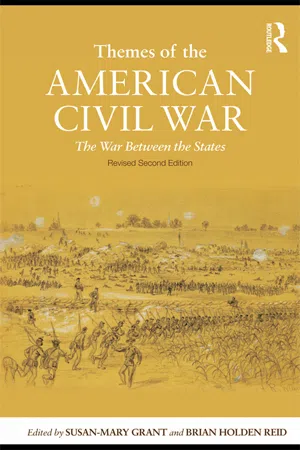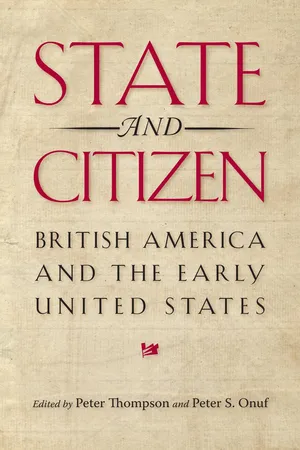History
Confederate Economy
The Confederate economy refers to the economic system of the Confederate States of America during the American Civil War. It was primarily agrarian, relying heavily on cotton and tobacco production, and lacked the industrial infrastructure of the Union. The Confederate economy faced significant challenges due to blockades, inflation, and resource shortages, contributing to the eventual defeat of the Confederacy.
Written by Perlego with AI-assistance
Related key terms
5 Key excerpts on "Confederate Economy"
- eBook - ePub
Themes of the American Civil War
The War Between the States
- Susan-Mary Grant, Brian Holden-Reid(Authors)
- 2009(Publication Date)
- Routledge(Publisher)
5The Southern War Economy
When both sides went to war, they expected it to be of short duration and foresaw little economic disruption. Both predictions proved hopelessly wrong. Every significant feature of the Union and Confederate economies was touched by the four years of bitter conflict. This was particularly true of the South, which was driven by economic as well as military necessity to employ ever more drastic measures and even to consider the arming of its slave population, an idea which would have astounded every white southerner a few years earlier. Indeed, for the Confederacy the war years were ones of increasingly severe economic dislocation and, for the overwhelming majority of its white citizens, of unwontedly severe hardship.6The Confederate Economy was plagued by problems from the outset. Although the Northern embargo and blockade were not entirely successful, they reduced the cotton trade by perhaps as much as 90 percent. (A further difficulty arose since 1860 had seen a bumper cotton crop and the British market was all but glutted.) As a result, and since southerners had, on the outbreak of war, repudiated at least $300 million in debts to Northern banks and merchants, the Confederacy was starved of credit and capital. This made imports the more difficult to finance. Except in New Orleans, banks suspended specie payments for the duration of the conflict. Faced with declining revenues and mounting expenditure, the Confederate government had little choice but to issue paper money in the form of treasury notes, which eventually totaled well over a billion dollars. Inevitably the money depreciated with the declining economic and military fortunes of the Confederacy so that rapid inflation and hoarding of foodstuffs occurred on an ever greater scale. Indeed, a vicious cycle was created as the Confederate government authorized army officers to seize foodstuffs and pay for them at confiscatory prices; the result was yet more hoarding and a still deeper food crisis.7 - eBook - ePub
Confederate Political Economy
Creating and Managing a Southern Corporatist Nation
- Michael Brem Bonner(Author)
- 2016(Publication Date)
- LSU Press(Publisher)
Their ideas of political economy are enough to drive the venerable A. [Adam] Smith out of his quiet resting place with a fresh edition of the “Wealth of Nations” in his claw.—Lord Lyons to Lord Russell, May 21, 1861W hen making this statement to his superior, British ambassador to the United States Lord Lyons was describing the Confederacy’s ill-considered policy of “King Cotton” diplomacy. However, Lyons’s remark that the father of modern capitalism, Adam Smith, would be upset by the Confederacy’s distortion of long-standing economic principles, implied that Confederate political economy was not truly a capitalist system. Lyons’s critique of “King Cotton” diplomacy was understandable, but his suggestion that the Confederacy was not a capitalist system was inaccurate. Capitalism was the guiding philosophy of Confederate political economy. It is debatable how much the existing system of slaveholding capitalism affected the war effort, but circumstances dictated that the wartime version of Confederate capitalism be suited to national survival.1 Confederate leaders were forced to adapt methods that anticipated future capitalist development instead of mimicking established economic norms.The Confederacy clearly fits the definition of a modern corporatist economy. As noted by Nobel Laureate economist Edmund Phelps, “a modern economy ... means not a present-day economy but rather an economy with a considerable degree of dynamism—that is, the will and the capacity to innovate.” In the areas of political culture, industrial organization, and railroad policy, the Confederacy attempted innovations that drastically departed from antebellum norms. Even though most of the technology was borrowed, the Confederacy was very innovative; it had to be in order to survive. Edmund Phelps also described the modernist style of Confederate innovation when he defined “the modern economy ... [as] a vast imaginarium—a space for imagining new products and methods,” and the Confederacy certainly exhibited numerous examples of how a modern economy’s “innovation process draws on human resources not utilized by a premodern economy.”2 - eBook - ePub
State and Citizen
British America and the Early United States
- Peter Thompson, Peter S. Onuf(Authors)
- 2013(Publication Date)
- University of Virginia Press(Publisher)
Civil War. I attempt to recast economic nationalism, however, in broader terms. Economic nationalism is not so much a series of specific economic policies but rather is a more generalized concept in which independence movements create “imagined economies” that articulate a possible economic future. Both colonists and Confederates had to answer a series of economic questions to make a persuasive case for independence. How would the new nation trade with other countries, especially the former “mother” country? Would the new nation remain agricultural, or would it seek to foster cities and manufacturing? What role would the state play in fostering economic development? In the heated debate over rebellion and independence, colonists and Confederates alike answered these questions in speeches, pamphlets, and editorials. In both discourses of independence, visualizing an imagined economy became an essential part of creating an imagined community. 3 The colonists put forward a relatively conservative economic vision in which independence would reinforce its role as a commodity producer in the Atlantic economy. During the decade leading up to the Revolutionary War, most colonists readily accepted an economic role within the British Empire as a producer of commodities and a consumer of manufactured goods. When the colonies declared themselves independent, they invoked natural rights ideology to justify free trade with other nations. Free trade, however, was designed to reinforce international exports of staple crops rather than revolutionize the American economy. Confederate secessionists viewed political independence much differently—they saw it as an opportunity to create a more modern economy. Secessionists often celebrated free trade, believing that such policies would divert capital and trade to the South so that cities such as Norfolk, Charleston, and Savannah would become the continent’s great commercial centers - eBook - ePub
Colossal Ambitions
Confederate Planning for a Post–Civil War World
- Adrian Brettle(Author)
- 2020(Publication Date)
- University of Virginia Press(Publisher)
Sound finances had to be the priority for the government, and planners for the new nation expressed remorse over the memory of the 1840s debt defaults by southern states. Diplomats tracked the performance of the Cotton Loan in London and Paris and compared it with the dollar—gold convertibility prices in New York. Such present-day preoccupations had future consequences for what planners wished the Confederate Economy to become. They had to adjust their preferred vision of a world with nations connected by free trade and cooperative economies devoted to comparative advantage. Instead, with a more mercantilist way of thinking about the economy, the Confederacy aimed for a trade surplus, and hence a flow of gold and silver into Confederate coffers. Imports would be limited by the establishment of a significant manufacturing sector—economic planners not only sought to import goods and knowhow in order to boost wartime munitions production; they also consciously set about the development of new advanced industries. 1 Electoral and military issues had to be resolved before any clarification of the future relations between the Confederacy and the United States. In terms of any territorial settlement, leading Confederates continued to resist any idea of uti possidetis (what you have you hold); aiming instead to recover lost land via postwar state conventions and even by military reconquest. At the same time, the imminence of the U.S. presidential elections meant the defeat of Lincoln would quickly deliver peace. Would-be Confederate negotiators reacted to this situation by debating the extent to which they should be magnanimous toward the Union in the context of what they believed to be a victory. Tactically, they wondered if they should try and help secure this outcome by actively seeking to boost the electoral fortunes of northern Democrats with offers of commercial and even military alliance - eBook - ePub
- David Herbert Donald(Author)
- 2015(Publication Date)
- Golden Springs Publishing(Publisher)
Where differentials are examined, they can be measured more precisely in economic terms than in any other, and historians have long been impressed by the great economic superiority of the North. Here there are innumerable measurements—of manpower, of wealth, of railroad mileage, of industrial capacity—all of which point up the overwhelming advantage on the side of the Union. These comparisons have led many writers to conclude that the South was fighting against the census returns and that Northern victory was inevitable from the beginning.One-sided as these statistical comparisons are, even they fail to reveal in full the economic handicaps of the South. No statistics can measure, for instance, how much the Confederacy suffered from the fact that it had the kind of economy that is prostrated by war, in contrast to the Union which had the kind of economy that flourishes under wartime conditions. War invigorated the Northern economy by stimulating a leading form of Northern economic activity, namely industrial production. Thus the conflict brought prosperity to the civilian population, and civilian morale remained good largely because civilians had nothing to be demoralized about. But in the Confederacy, war paralyzed the chief form of economic activity, which was the cultivation of cotton. As the flow of income from cotton dried up, the economy languished, the economic welfare of civilians suffered, and their morale deteriorated. In the end, the economic morale of the people collapsed before their military morale was exhausted.In terms of economic logic, it can perhaps be demonstrated that the Confederacy, hopelessly overmatched by almost every measure of strength, was doomed to defeat. But history not only shows that in war the lighter antagonist sometimes defeats the heavier, it also shows that what seems logically certain often fails to happen. Thus, if we survey the course of the Civil War, do we not find that, in actuality, the Confederacy developed very formidable striking power—power impressive enough to make Lincoln doubt, even as late as 1864, that the Union would be saved? Do we not find the effective power of the opposing forces balanced so evenly that sometimes great results seemed to swing on the hinge of relatively trivial events? If a Confederate soldier had not shot Stonewall Jackson in the dusk at Chancellorsville, if Gouverneur Warren had not had a quick eye for Little Round Top, if a duplicate copy of Lee’s plan of campaign in September, 1862, had not been used by someone on D. H. Hill’s staff to wrap three cigars, might not a delicate balance have swung the other way in spite of all the statistics?
Learn about this page
Index pages curate the most relevant extracts from our library of academic textbooks. They’ve been created using an in-house natural language model (NLM), each adding context and meaning to key research topics.




